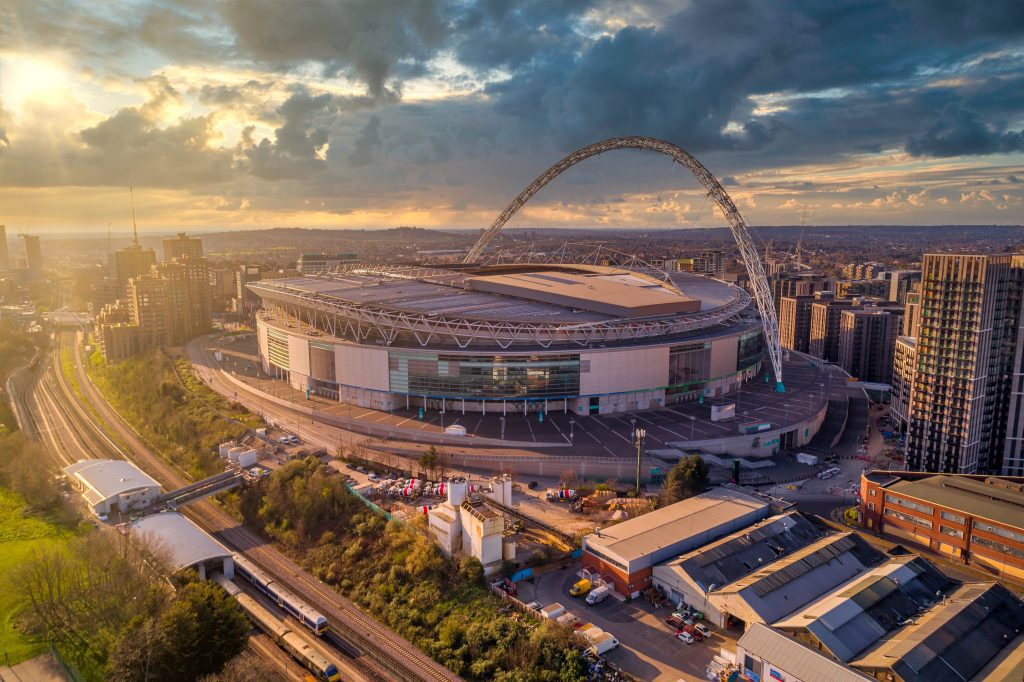The 2023–24 UEFA Champions League is the 69th season of Europe’s premier club football tournament and the 32nd season with the current name.
32 teams participate in the group stage and in this article, we will have a look at their stadiums.
Group A
The Allianz Arena is the second largest stadium in Germany with a capacity of 75,000. The stadium hosted the 2012 UEFA Champions League Final. It opened in 2005 and since then it has been the home stadium of the German champions Bayern Munich. The club has won the Champions League 3 times.
The largest football stadium in Denmark is the Parken with a capacity of 38,000. It opened in 1992 and is the home of the Danish champions, FC Copenhagen. The club has advanced to the Round of 16 in 2010-2011.
The Ali Sami Yen Stadium is the home of the Turkish champions, Galatasaray. It opened in 2007 and has a seating capacity of 52,200. The club reached the semifinals in the 1988–1989 campaign.
The second largest stadium in England with a capacity of 74,300 is the Old Trafford. It opened in 1910 and since then it has been the home of Manchester United. The club has won the title 3 times.
Group B
The Emirates Stadium has a current seated capacity of 60,700, making it the fifth-largest football stadium in England. It has been the home stadium of Arsenal Football Club since its completion in 2006. The club has reached the final once.
The Stade Bollaert-Delelis opened in 1993 in Lens, France, and has a capacity of 38,200. That’s 7,000 more than the city population. The stadium serves as the home to Lens. The club has never advanced above the group stage in two appearances in the competition.
The venue for the 1986 Final was the Ramón Sánchez Pizjuán Stadium, home of Sevilla Fútbol Club. It opened in 1958 and now has a total capacity of 42,700. Sevilla has reached the quarter-finals of the competition twice.
The third-largest football stadium in the Netherlands with a capacity of 35,000 is the Phillips Stadion in Eindhoven. It opened in 1910 and since then it is the home stadium of PSV Eindhoven. The club has won the title in 1988.
Group C
The Stadio Diego Armando Maradona opened in 1959 and is the home of the Italian champions, SSC Napoli. The club’s best performance is reaching the quarter-finals in the last year’s competition.
With a seating capacity of 83,000, Santiago Bernabeu is the second-largest stadium in Spain, and it has been the home stadium of Real Madrid since its completion in 1947. Real is the most successful team in the Champions League having clinched the title 14 times. The stadium has hosted the tournament final in 4 occasions.
The Estádio Municipal de Braga opened in 2003 and has a capacity of 30,200. The stadium serves as the home to SC Braga. The Portuguese side has played in the group stage of the Champions League twice, without ever advancing to the next stage.
The Olympiastadion will be used by Union Berlin for their 1st appearance in the group stage of the Champions League. It opened in 1936 and has a capacity of 74,000. It hosted the 2015 UEFA Champions League Final.
Group D
The second smallest stadium in the group stage with a capacity of 30,000 is the Red Bull Arena in Salzburg. It serves as the home to the Austrian champions, Red Bull Salzburg. The club’s best performance is reaching the round of 16 in 2022.
The largest stadium in Italy with a capacity of 80,000 is the San Siro in Milano. The stadium has hosted 4 Champions League finals. It is the home of the three-times European champions, Inter and the seven-times champions, AC Milan.
The Anoeta Stadium opened in 1993 and has a capacity of 39,000. It is the home of Real Sociedad. The club has reached the round of 16 once in 4 appearances.
The biggest stadium in Portugal with a capacity of 64,600 is the Estádio da Luz in Lisbon. It opened in 2003 and has hosted two Champions League finals. It is the home ground of Benfica. The club has won the title two times.
Group E
The 2nd largest stadium in the Netherlands with a capacity of 51,100 is the De Kuip in Rotterdam. The stadium has hosted the European Cup final twice. It opened in 1937 and since then it has been the home ground of Feyenoord. The club has won the title in 1970.
The Metropolitano Stadium in Madrid has a capacity of 70,460 and hosted the 2019 Champions League final. It serves as the home to Atletico Madrid. The club was Champions League runners-up on 3 occasions.
The 2nd largest stadium in Italy with a capacity of 70,000 is the Stadio Olimpico in Rome. It opened in 1953 and since then it has been the home of Lazio. The club’s best performance in the competition was reaching the quarter-final in 2000.
The largest football stadium in Scotland with a capacity of 60,400 is the Celtic Park in Glasgow. The stadium opened in 1887 and since 1892 it has been the home ground of Celtic. In 1967, Celtic became the 1st British team to win the title.
Group F
The Parc de Princes has a seating capacity of 47,929 spectators and has been the home of Paris Saint-Germain since 1974. The club lost in the final of the 2019-2020 season.
The St James’ Park has a seating capacity of 52,300 and opened in 1892. Since then, it has been the home of Newcastle United. The club will play this year in their 3rd Champions League competition.
The largest stadium in Germany with a capacity of 81,300 is the Westfalenstadion, home to Borussia Dortmund. The club has won the Champions League title in 1997.
The largest stadium in Italy with a capacity of 80,000 is the San Siro in Milano. The stadium has hosted 4 Champions League finals. It is the home of the three-times European champions, Inter and the seven-times champions, AC Milan.
Group G
The Red Bull Arena in Leipzig opened in 2004 and has a capacity of 47,000. The stadium is the home of RB Leipzig. The club reached the semi-finals of the 2019–2020 Champions League.
The City of Manchester Stadium opened in 2002 and can hold 53,400 spectators. It is the home of the current Champions League winners, Manchester City FC.
The largest stadium in Serbia with a seating capacity of 53,000 is the Red Star Stadium in Belgrade. It opened in 1963 and has hosted the 1973 final. It is the home ground of Red Star Belgrade who won the title in 1991.
The Wankdorf Stadium opened in 2005 and can hold 32,000 people. It is the home ground of the Swiss champions, BSC Young Boys. The club has never progressed above the group stage of the competition.
Group F
The Estadi Olímpic Lluís Companys will be the home of Barcelona for this season. It opened in 1927 and has a capacity of 54,300. Barcelona has won five 5 Champions League titles.
The Estádio do Dragão opened in 2003 and has a capacity of 50,000. The stadium hosted the 2021 final and is the home ground of FC Porto. The club has won the title two times.
The Volksparkstadion in Hamburg, Germany will host the games of Ukrainian champions FC Shakhtar Donetsk. The stadium opened in 1953 and can hold 57,000 people. Shakhtar has reached the quarterfinals in 2011.
The smallest stadium in the competition with a capacity of 16,000 is the Bosuilstadion home of the Belgian champions Royal Antwerp F.C. The club qualified for the Group stage of the Champions League for the first time in 2023.




